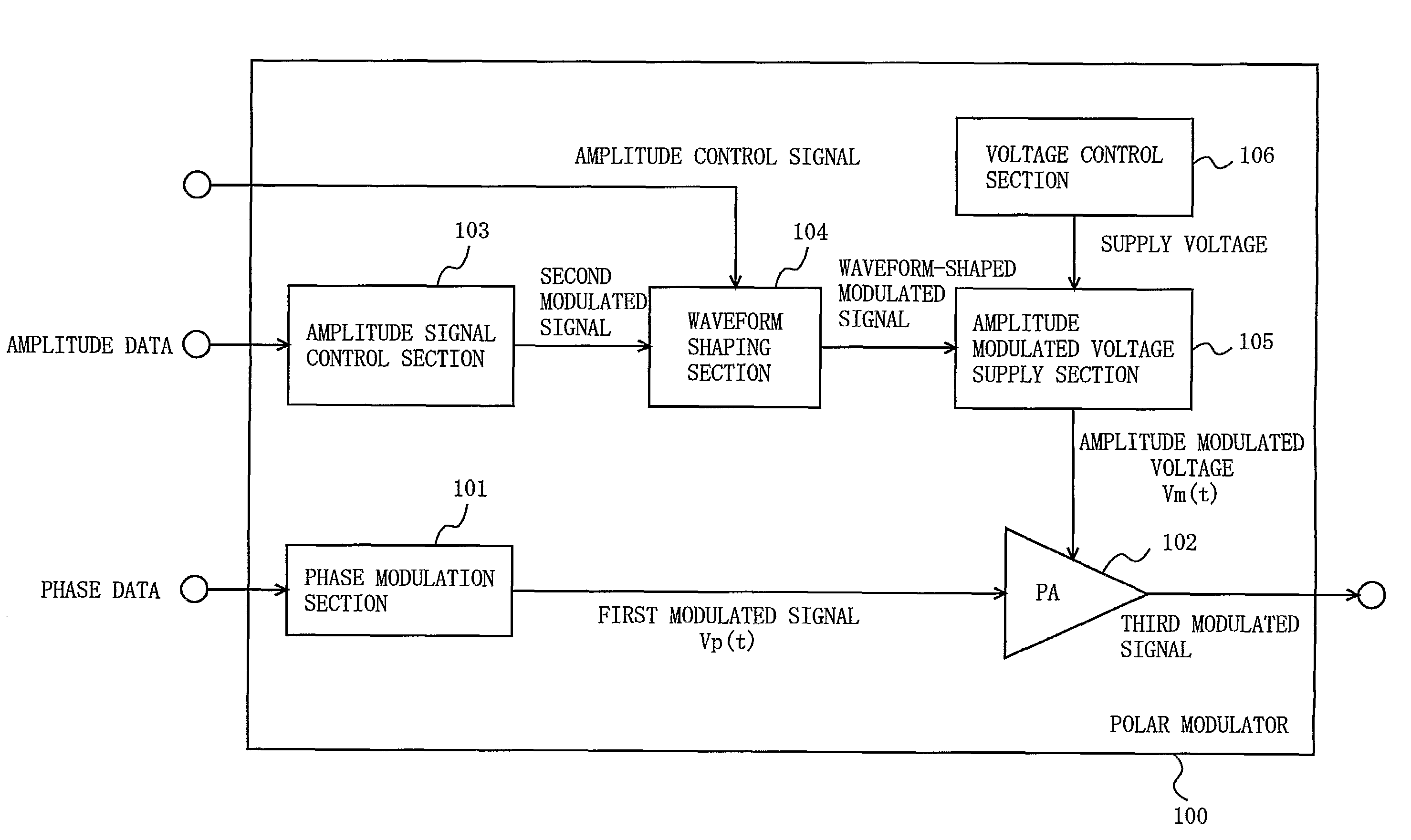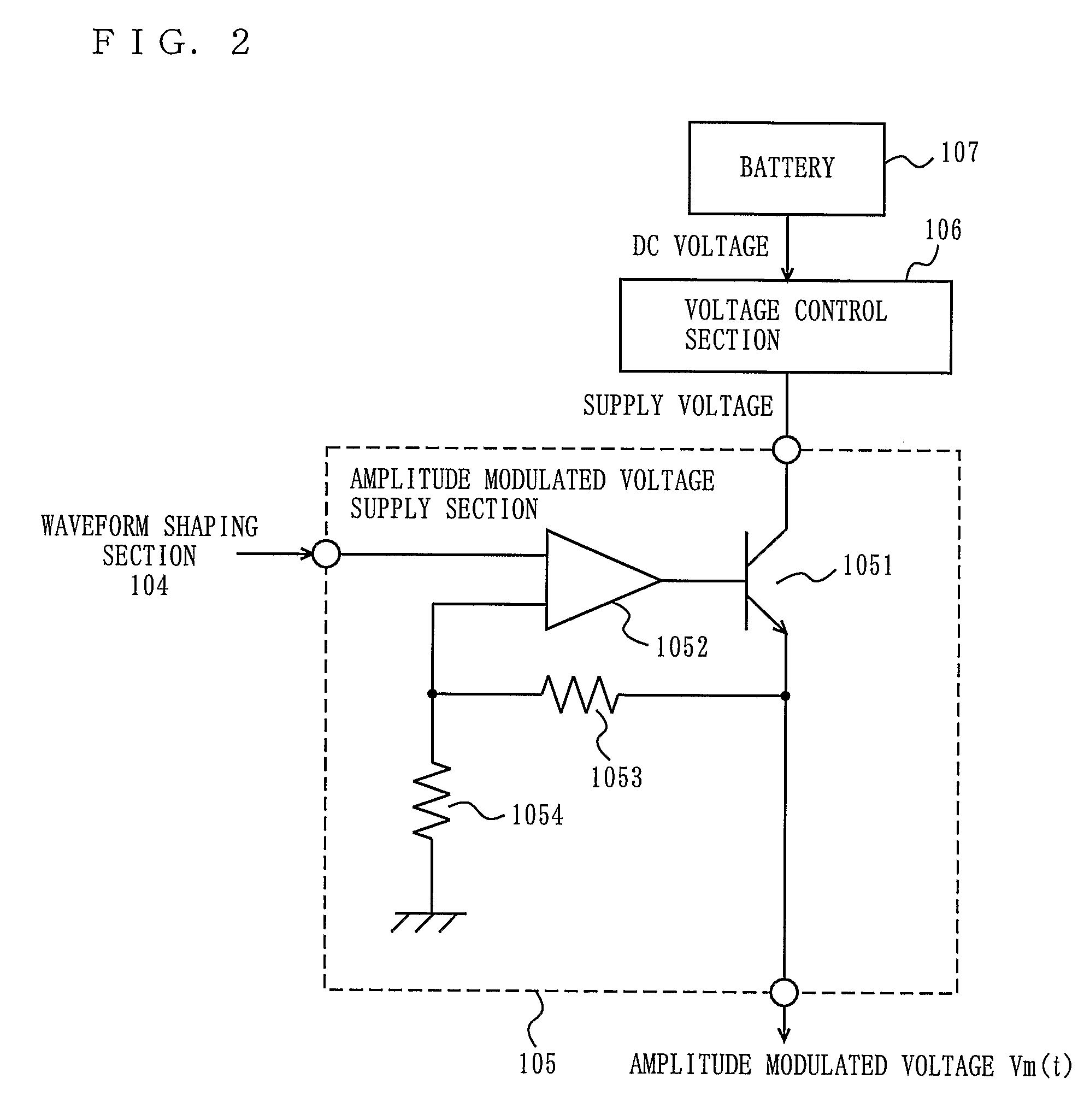Polar modulator and wireless communication apparatus using the same
a wireless communication apparatus and modulator technology, applied in the field of modulation devices, can solve the problems of reducing operation efficiency, increasing size and cost, and especially consuming power for transmitting power to antennas, so as to improve power utilization efficiency, accurate amplitude modulated voltage, and accurate modulation
- Summary
- Abstract
- Description
- Claims
- Application Information
AI Technical Summary
Benefits of technology
Problems solved by technology
Method used
Image
Examples
first embodiment
[0078]FIG. 1 is a block diagram showing a functional structure of a polar modulator 100 according to a first embodiment of the present invention. As shown in FIG. 1, the polar modulator 100 includes a phase modulation section 101, a power amplification section 102, an amplitude signal control section 103, a waveform shaping section 104, an amplitude modulated voltage supply section 105, and a voltage control section 106.
[0079]A baseband section (not shown in FIG. 1) decomposes a baseband signal into amplitude data (I) and phase data (Q). When, for example, a QPSK (Quadrature-Phase Shift Keying) signal is used as a baseband signal, the baseband section decomposes the QPSK signal into amplitude data and phase data. The amplitude data is input to the amplitude signal control section 103. The phase data is input to the phase modulation section 101.
[0080]The phase modulation section 101 generates a first modulated signal Vp(t) including phase information based on the phase data, and outp...
second embodiment
[0125]FIG. 9 is a block diagram showing a functional structure of a polar modulator 200 according to a second embodiment of the present invention. In FIG. 9, elements having substantially identical functions to those of the polar modulator 100 shown in FIG. 1 bear identical reference numerals thereto, and descriptions thereof will be omitted. The polar modulator 200 includes a phase modulation section 101, a power amplification section 102, an amplitude signal control section 103, a waveform shaping section 204, an amplitude modulated voltage supply section 205, a voltage control section 206, and a switch section 207.
[0126]The voltage control section 206 includes first through third DC power supplies 206a, 206b and 206c capable of outputting a plurality of different supply voltages from one another.
[0127]The amplitude modulated voltage supply section 205 includes first through third series regulators 205a, 205b and 205c respectively provided in correspondence with the first through ...
third embodiment
[0132]FIG. 10 is a block diagram showing a functional structure of a polar modulator 300 according to a third embodiment of the present invention. In FIG. 10, elements having substantially identical functions to those of the polar modulator 100 shown in FIG. 1 bear identical reference numerals thereto, and descriptions thereof will be omitted. The polar modulator 300 includes a phase modulation section 101, a power amplification section 102, an amplitude signal control section 303, an amplitude modulated voltage supply section 305, and a voltage control section 306.
[0133]The amplitude signal control section 303 has substantially the same function as that of the amplitude signal control section 103 in the first embodiment except for inputting the second modulated signal to the voltage control section 306 and the amplitude modulated voltage supply section 305.
[0134]The amplitude modulated voltage supply section 305 includes a transistor. The amplitude modulated voltage supply section ...
PUM
 Login to View More
Login to View More Abstract
Description
Claims
Application Information
 Login to View More
Login to View More - R&D
- Intellectual Property
- Life Sciences
- Materials
- Tech Scout
- Unparalleled Data Quality
- Higher Quality Content
- 60% Fewer Hallucinations
Browse by: Latest US Patents, China's latest patents, Technical Efficacy Thesaurus, Application Domain, Technology Topic, Popular Technical Reports.
© 2025 PatSnap. All rights reserved.Legal|Privacy policy|Modern Slavery Act Transparency Statement|Sitemap|About US| Contact US: help@patsnap.com



